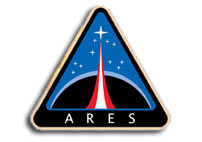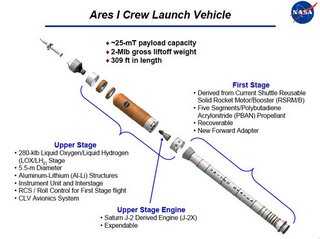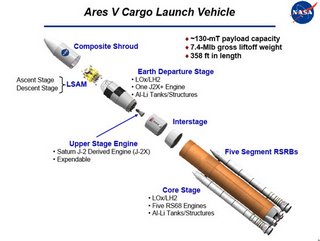
With the launch of Discovery delayed until at least tomorrow, it is time to do another unfocused rambling rant on space stuff(actually it is waaaay over-due but I've been busy).
NASA has officially named the new launchers for project Constellation, They will be named the Ares 1 and Ares 5. This is both reminiscent of the Apollo Programmes Saturn series and is an unmistakable hint as to where NASA is setting is sights.

At Xena and Wonder Woman villains.
ahem....
...but it is obvious that NASA is not only looking back to that old Apollo spirit but forward to what they intend to be a primary goal. (That's Mars for those who don't know their Edith Hamilton.)
One wonders if NASA can avoid the mistakes made in that program which pretty much gutted the commercial space sector and despite getting to the moon, left no infrastructure in space for future civil development (as had been planned by most serious rocket pioneers previously) and left us with six flags on the moon.....instead of vacations at Six Flags on the Moon.

I'm fairly optimistic that they can, in part because of things like this speech by Chairman Griffin linked to here, and news of the prizes involved for orbital propellant depots that I linked to in this previous post. I see interviews like this one with Gingrich and the recent emphasis on C.O.T.S. and am pretty sure that Griffin at least is determined to move the US into space in a cohesive way as opposed to the top-down centalized model that gave us a manned spaceflight program nothing in 34 years but wrecked ships , dead crews, 113 voyages in a big circle and a half finished lab of limited utility in an awkward orbit....Oh, and plans...lots and lots of plans for all sorts of stuff that never seems to get built.
Assuming that things go well and the current program results both directly and indirectly with cislunar space being much more accessible there is considerable money to be made even without taking far term prospects like He3 into account. This Space Review article points out one problem with fuel cell technology that isn't getting a lot of play, but is serious, namely the use of rare elements like platinum in the devices themselves. Of course, as the article points out, this is a deal breaker barring a new source...like the moon and the asteroids which could make some enterprising saviors of humanity pretty rich in the fairly near term. The numbers are striking, with China's auto industry poised to take a huge bite out of the terrestrial platinum reserves, and the requirements, if fuel cells take off as hoped, exceeding current capacity even without that complication.
Once NASA no longer has to sink money and thought into re-doing what was cutting edge 34 years ago they can focus on more ambitious goals that are at least as challenging as the moonshots were to the agency's founders. One of those never completed plans I mentioned above was such a project, no, not a Mars shot, though I strongly support that goal, the math on that was worked out in the 40s , no, the NASA engineers in the early 'naughts actually worked out the numbers on a MANNED mission to Jupiter! Called the HOPE project, this unfathomably cool project had everything, including teleoperated submarines on Europa and space robots. The first I heard about it was in this Space Review article. I've been able to track down little other info but did turn up this PDF presentation of the spaceships, a series of ion propelled cargo vessels and an impressive manned craft with spin generated artificial gravity. The idea was to land on Callisto just outside Jupiters fearsome radiation belts and exercise near real-time control over robotic probes throughout the Jovian system without the awkward lightspeed delay that inhibits even the Martian rovers. The technology for this would seem to be very applicable to a Saturnian mission especially given the much more benign radiation field there as well as Titan and Enceladus...which just cry out to be visited.
On a more down to earth note, Mark Wade has updated his Blog, on the other hand he has no permalinks, on the gripping hand he makes some VERY good points about what sort of priorities our research should have so I'll cut and paste liberally.
Take it away Mr. Wade....
*Artificial-G. Four decades have shown that zero-G is bad news to the human body. It has also shown that astronauts living in zero-G for months at a time are going to have a hard time getting around upon arrival at Mars or return to the earth. The obvious conclusion is that artificial G, produced by spinning the living spaces during transit, will be necessary fro the health of the crew and their ability to function on arrival. This research can only be done in space. Ground-based experiments have only resulted in insoluble controversies. The following need to be solved before once can even design an interplanetary spacecraft:
What minimum radius of spin arm is necessary to provide the artificial G while preventing problems for the crew with balance and inner-ear disorders?
Is the deterioration of the bones and muscles under zero-G arrested by living under 1/6 G (moon gravity)? Or 40% G (Mars gravity)? Or are the effects still negative, but proportional to the G-force? Or is there some other relationship?
Is the ideal profile for flight to Mars to start out at 1-G, reduce to 40% G at arrival on Mars, then the same in reverse for the return? Or is it better to have 1-G all the way? Or something else?
*Super-reliable, leak-proof systems capable of storing and reliquefying cryogenic propellants for years need to be designed, developed, and flown for a couple of years in earth orbit.
*Long term human colonization will require reliable, long-term artificial ecosystems that will convert carbon dioxide to oxygen, regenerate water, and provide food for the crew. These need to be developed, then tested for years in 1/6 and 40% G.
*Human deep space exploration needs to be profoundly low-tech. When you are talking about expeditions lasting for years away from resupply, you cannot have sophisticated systems needing spare parts from earth. If you're going to live on another planet indefinitely, you cannot have anything that cannot be replaced locally. To that end, power generation systems, life support systems, spacecraft orientation systems, surface rover systems, all have to be constructed of mechanical components that can be repaired and even fabricated from raw metallic stock carried aboard, and eventually smelted locally.
All of which are VERY good points often overlooked. On the artificial G front there was a variable gravity module that was to be installed on the ISS, but this most promising of ALL the experiments on that project has been cancelled. Boeing is still hocking it here Another proposal along those lines is at once more versatile and robust and meshes well with proposals for an L-1 gateway station. The Clarke Station proposal uses Bigelows inflatable modules as well as water for rad shielding. It is specifically designed as a variable gravity facility for answering with hands on experience exactly the questions Mr. Wade so astutely poses. Some of those questions are answered in theory here, but while we can run the math with little problems, the actual physiological effects of various gravities, spin diameters and rotation rates need to be learned about first hand.
With regards to his statement on the need for low tech solutions he is absolutely right IMHO. While I am a tech geek and have naught but contempt for luddites of any stripe, KISS (Keep It Simple Stupid) is a profoundly important buzzword too often ignored by engineers. It is also necessary to open space to the homesteaders of the future.
That future I keep hearing about...It's just about here. :)
No comments:
Post a Comment